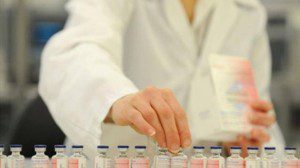 It may come as a surprise to many that diabetes can affect both humans and animals. Treatment for diabetes in humans is much easier because they’re usually willing to take steps to mitigate the effects of the disease, but it’s impossible to communicate the risks of diabetes to a pet. Any treatment plan for diabetes must be based on accommodating fluctuations in blood sugar; however, such fluctuations can be difficult to detect in pets.
It may come as a surprise to many that diabetes can affect both humans and animals. Treatment for diabetes in humans is much easier because they’re usually willing to take steps to mitigate the effects of the disease, but it’s impossible to communicate the risks of diabetes to a pet. Any treatment plan for diabetes must be based on accommodating fluctuations in blood sugar; however, such fluctuations can be difficult to detect in pets.
Nadja Affenzeller and her colleagues at the University of Veterinary Medicine in Vienna may have found a solution to the problem. Affenzeller and her team have shown that a commercially-available blood glucose monitoring system can be utilized with dogs at any time, even when they’re outside of a clinic. The information provided by the glucose monitoring can help veterinarians in deciding on the dog’s treatment.
Diabetes, when it goes unmanaged, can lead to a significantly impaired life for both humans and pets. After an individual develops diabetes, care must be taken to maintain insulin levels near those of a non-diabetic. Recent advances in diabetes treatment have led to novel insulin therapies but such medications often require near-constant monitoring of blood glucose levels. Such information can be recorded while the patient is in the clinic but a variety of variables, such as stress, the time of the last meal, and exercise may affect the results. Therefore, it’s must more effective to obtain data on insulin levels while the individual is living his or her normal daily life.
Mennarini Diagnostics has developed a system called GlucoDay for continuous blood sugar monitoring in human diabetics. The system measures a wide range of glucose concentrations, which means that it could also be used in animals. Affenzeller and her team tested the GlucoDay system in ten diabetic dogs, all of which were believed to be receiving appropriate treatment with insulin. The test results were mostly positive, with the system being well-tolerated and working under the test conditions, aside from the loss of one apparatus in a fight and the breakdown of two of the systems before the end of the test.
The researchers were surprised by the results of the test: according to the GlucoDay monitoring, none of the dogs were receiving optimum treatment for diabetes. Using the data, scientists were able to make recommendations for more appropriate treatment, such as increasing dosage of insulin or altering diets.
Affenzeller commented that although the test showed that the dogs were not receiving proper care, the findings are not a sign of poor treatment by the doctors but rather an indication of the difficulty in accurately measuring glucose levels in animals such as dogs. “The information on the dogs’ glucose levels was easy to interpret and enabled us to improve the treatment in every single case,” said Affenzeller. “This doesn’t mean that the vets hadn’t done their work properly but shows how difficult it is to determine appropriate treatment without detailed information of this kind.” The constant monitoring of glucose levels that the GlucoDay system provides could be a catalyst for providing diabetes treatment for dogs that is just as effective as what humans receive.
The research paper, authored by Affenzeller along with Johann G. Thalhammer and Michael Wilmann, is titled “Home-based subcutaneous continuous glucose monitoring in ten diabetic dogs – a case series study” and is published in the journal “The Veterinary Record.”
 Scientists in Australia have revealed that they could be on the verge of an exciting development in reversing Type 2 diabetes. The researchers’ discovery involves a specific gene and its disruption of
Scientists in Australia have revealed that they could be on the verge of an exciting development in reversing Type 2 diabetes. The researchers’ discovery involves a specific gene and its disruption of  A study released Monday suggests that children who have been diagnosed with diabetes are at increased risk of developing asthma. In addition, blood glucose regulation seems to be more difficult for children who have both asthma and diabetes. The study was published in the journal “Pediatrics.”
A study released Monday suggests that children who have been diagnosed with diabetes are at increased risk of developing asthma. In addition, blood glucose regulation seems to be more difficult for children who have both asthma and diabetes. The study was published in the journal “Pediatrics.” Researchers at UCLA demonstrated that the common over-the-counter dietary supplement gamma-Aminobutyric acid (also known as GABA) may aid in inhibiting the development of
Researchers at UCLA demonstrated that the common over-the-counter dietary supplement gamma-Aminobutyric acid (also known as GABA) may aid in inhibiting the development of  Having insects liquefy and digest the dead tissue from your wounds might not be the most appealing idea, but a research team in Hawaii has done just that — using maggots to clean infected and dead tissue from wounds in diabetics — with very positive results.
Having insects liquefy and digest the dead tissue from your wounds might not be the most appealing idea, but a research team in Hawaii has done just that — using maggots to clean infected and dead tissue from wounds in diabetics — with very positive results. A recent preliminary study suggests that people taking the prescription drugs
A recent preliminary study suggests that people taking the prescription drugs  A small retrospective study recently presented at the annual meeting of the European Society for the Study of Diabetes has demonstrated that elevated accumulation of
A small retrospective study recently presented at the annual meeting of the European Society for the Study of Diabetes has demonstrated that elevated accumulation of  According to a recent study published in the October 1 issue of the “The American Journal of Cardiology,” percutaneous coronary intervention (or PCI) of chronic total occlusions (CTOs) is associated with reduced mortality in people with diabetes and can also reduce the need for coronary artery bypass grafting.
According to a recent study published in the October 1 issue of the “The American Journal of Cardiology,” percutaneous coronary intervention (or PCI) of chronic total occlusions (CTOs) is associated with reduced mortality in people with diabetes and can also reduce the need for coronary artery bypass grafting. A study recently reported in the journal “Pediatrics” has demonstrated that pregnant women with well-managed diabetes may not be at increased risk of giving birth to preterm infants or infants with very low birth weight.
A study recently reported in the journal “Pediatrics” has demonstrated that pregnant women with well-managed diabetes may not be at increased risk of giving birth to preterm infants or infants with very low birth weight. Previous research has suggested the possibility that having diabetes could increase an individual’s lifetime risk of also developing thyroid cancer. A new report, however, has solidified that claim, demonstrating that the association holds true for retirement-age Americans. The findings were published in the journal “Thyroid.”
Previous research has suggested the possibility that having diabetes could increase an individual’s lifetime risk of also developing thyroid cancer. A new report, however, has solidified that claim, demonstrating that the association holds true for retirement-age Americans. The findings were published in the journal “Thyroid.”